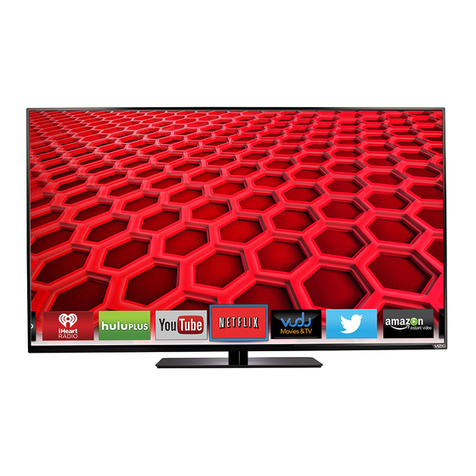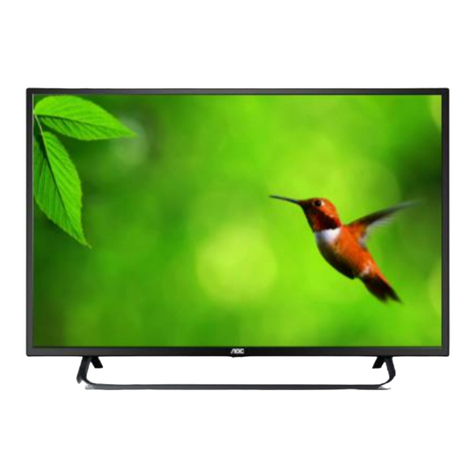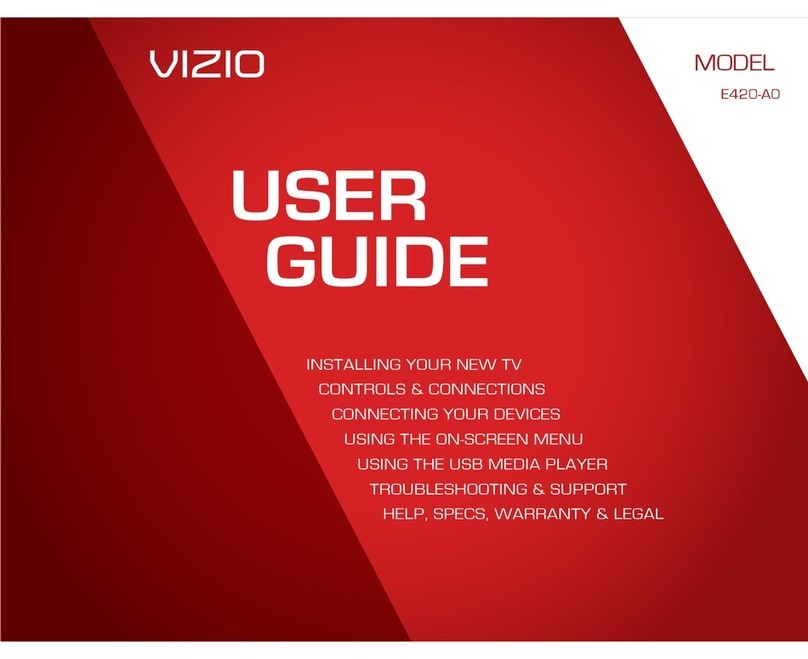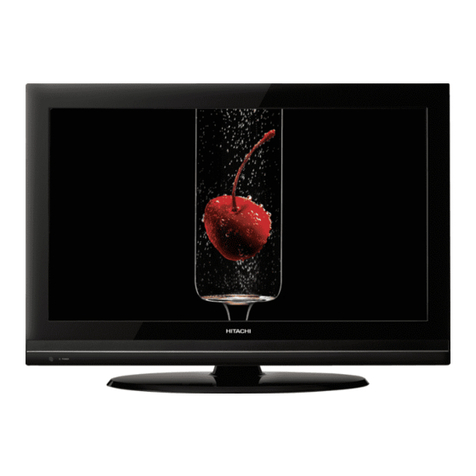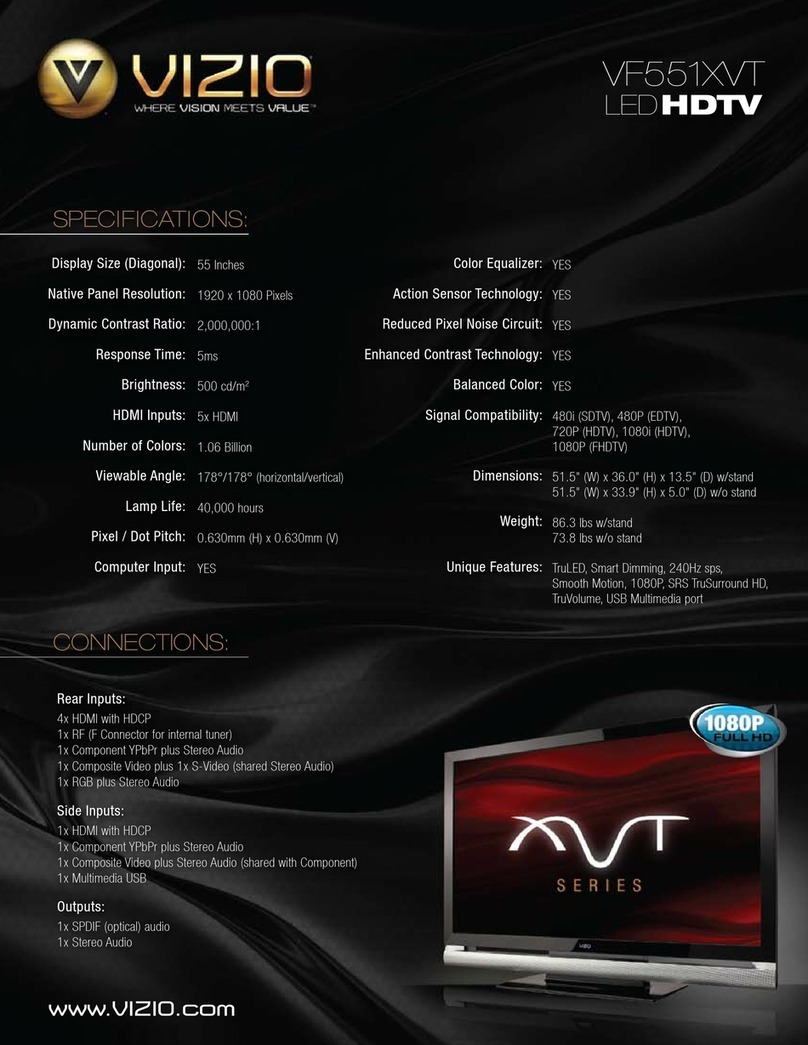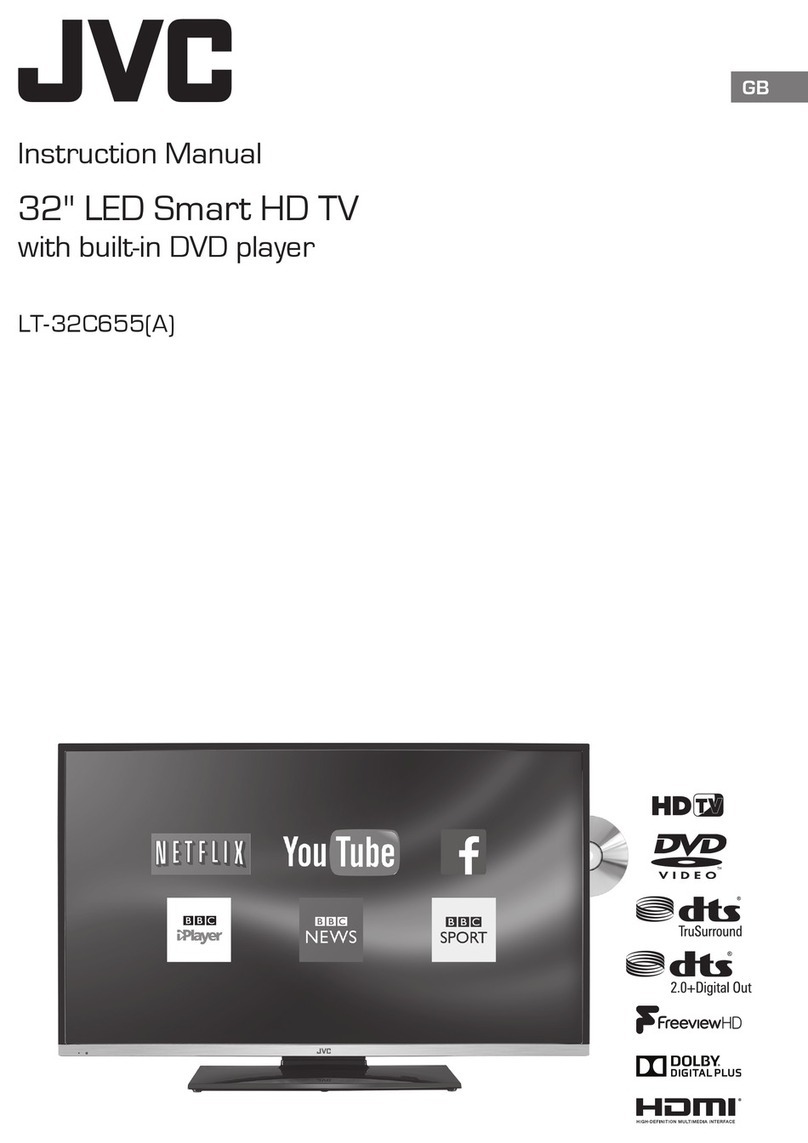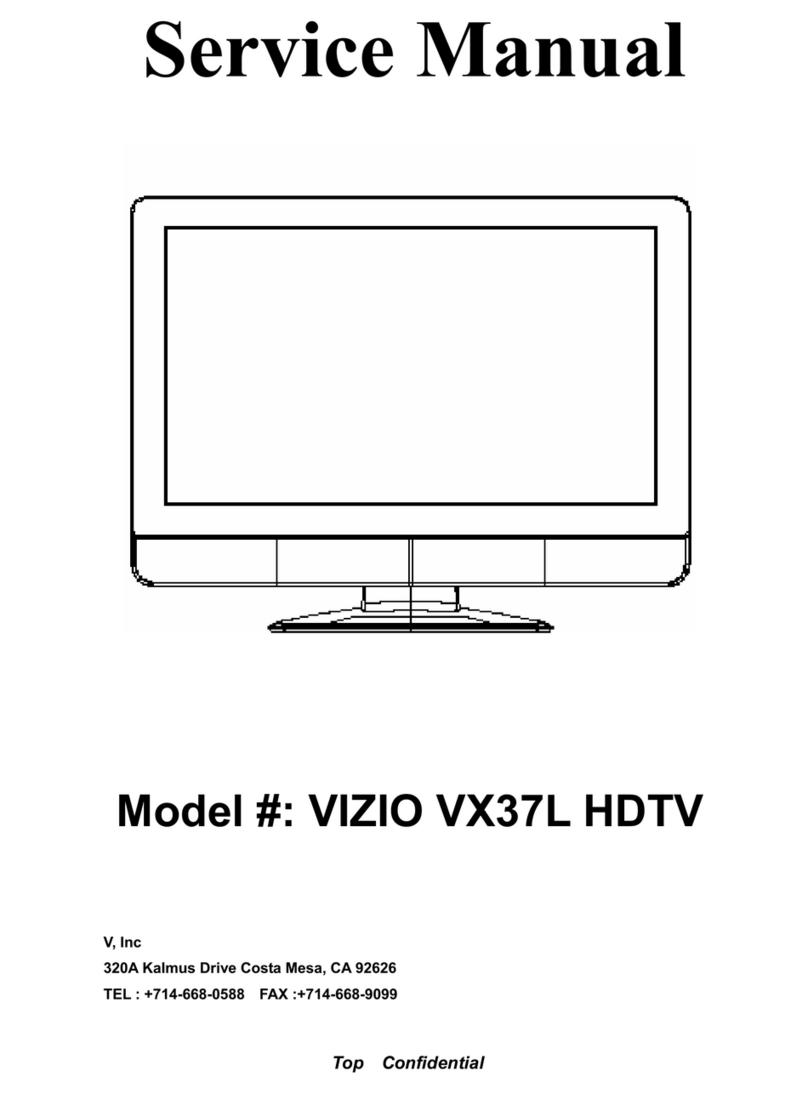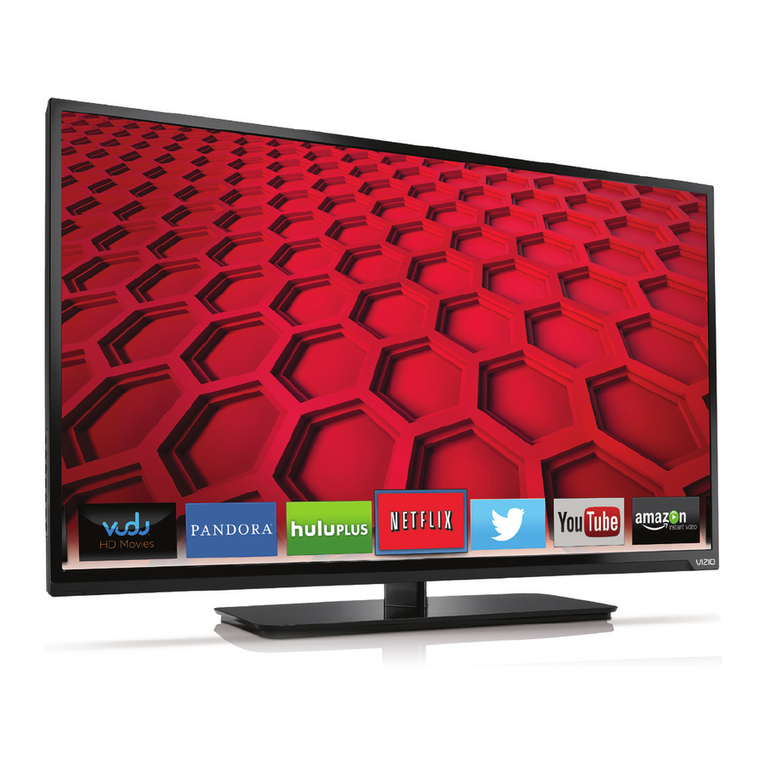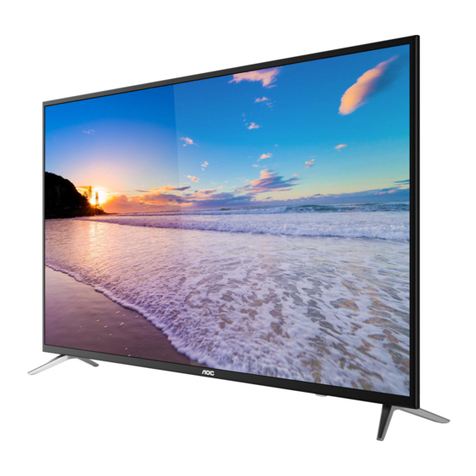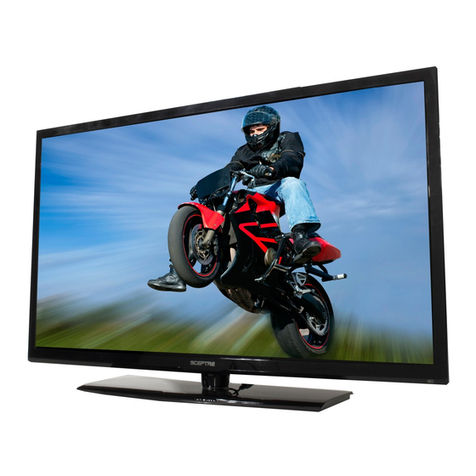Logic L20HE18 User manual

Instruction Manual
20” LED TV
L20HE18


Contents
Chapter 1 Safety Warnings ............................................................................................................................................................5
Chapter 2 Preparation ....................................................................................................................................................................8
Unpacking the TV ...............................................................................................................................................................................................................8
Installing / Removing the Base Stand .........................................................................................................................................................................9
− Installing the Base Stand......................................................................................................................................................................................9
− Mounting the TV to a Wall.................................................................................................................................................................................10
Front / Right Side View and Rear Controls...............................................................................................................................................................11
Rear View and Sockets....................................................................................................................................................................................................12
Installing Batteries in the Remote Control ..............................................................................................................................................................13
Remote Control Operation Range..............................................................................................................................................................................13
Remote Control .................................................................................................................................................................................................................14
Chapter 3 Connections .................................................................................................................................................................16
Making Video and Audio Connections.....................................................................................................................................................................16
Connecting an AV Device Using an HDMI Cable...................................................................................................................................................16
− Connecting a Soundbar - HDMI ARC (Audio Return Channel) ...........................................................................................................17
Connecting an Audio Receiver Using an Coaxial Cable .....................................................................................................................................17
Connecting an AV Device Using a Component (YPbPr) Cable ........................................................................................................................18
Connecting an AV Device Using a SCART Cable ...................................................................................................................................................18
Connecting an AV Device Using Composite Cable..............................................................................................................................................19
Connecting a Computer Using a VGA Cable ..........................................................................................................................................................19
Connecting to Network................................................................................................................................................................................................. 20
Connecting Headphones.............................................................................................................................................................................................. 20
Chapter 4 Initial Setup..................................................................................................................................................................21
Turning the TV On for the First Time .........................................................................................................................................................................21
− First Time Installation..........................................................................................................................................................................................21
− Target Region Setting (UK Only) .................................................................................................................................................................... 23
− Eco Friendly / Auto Standby Function ......................................................................................................................................................... 23
− Selecting the Input Source............................................................................................................................................................................... 24
− Channel Selection .............................................................................................................................................................................................. 24
− Listening to the Radio (Radio Mode)............................................................................................................................................................ 24
− Display Channel Information .......................................................................................................................................................................... 24
− Volume Adjustment............................................................................................................................................................................................ 24
Chapter 5 Customising TV Settings ............................................................................................................................................25
Picture Setting .................................................................................................................................................................................................................. 25
Sound Setting ................................................................................................................................................................................................................... 27
Channel Setting................................................................................................................................................................................................................ 28
− Auto Tuning (DTV / ATV Mode)....................................................................................................................................................................... 28
− Stereo / Dual Sound Reception (ATV Mode).............................................................................................................................................. 28
− Speaker Sound Output Selection (DTV Mode)......................................................................................................................................... 28
− Digital Manual Tuning (DTV Mode)............................................................................................................................................................... 30
− Analogue Manual Tuning (ATV Mode)......................................................................................................................................................... 30
− Channel Edit (ATV / DTV Mode).......................................................................................................................................................................31
− Signal Information (DTV Mode)...................................................................................................................................................................... 32
− Common Interface (DTV Mode) ..................................................................................................................................................................... 33
− Recorded List (DTV Mode)................................................................................................................................................................................ 34
− Schedule List (DTV Mode) ................................................................................................................................................................................ 34
− Over Air Download (DTV Mode)..................................................................................................................................................................... 35
PC Settings (PC Mode) ................................................................................................................................................................................................... 36
Select Sources................................................................................................................................................................................................................... 36
Time Settings..................................................................................................................................................................................................................... 37

Lock Setting ....................................................................................................................................................................................................................... 38
− System Lock........................................................................................................................................................................................................... 38
− Set Password ......................................................................................................................................................................................................... 39
− Channel Lock......................................................................................................................................................................................................... 39
− Parental Guidance ............................................................................................................................................................................................... 40
− Key Lock ...................................................................................................................................................................................................................41
Setup Settings................................................................................................................................................................................................................... 42
− Language................................................................................................................................................................................................................ 42
− Audio Language (DTV Mode).......................................................................................................................................................................... 42
− Subtitle Language (DTV Mode)...................................................................................................................................................................... 43
− Hearing Impaired................................................................................................................................................................................................. 43
− Blue Screen ............................................................................................................................................................................................................44
− HDMI CEC Control................................................................................................................................................................................................ 44
− Environment.......................................................................................................................................................................................................... 46
System Setting.................................................................................................................................................................................................................. 46
− Network Conguration ..................................................................................................................................................................................... 46
− PVR File System (DTV Mode)............................................................................................................................................................................ 47
− Software Update (USB) (DTV Mode)............................................................................................................................................................. 48
− Reset TV................................................................................................................................................................................................................... 48
Chapter 6 Using the Features ......................................................................................................................................................49
EPG (Electronic Programme Guide) (DTV Mode) ................................................................................................................................................. 49
− Switch On / O EPG............................................................................................................................................................................................. 49
− Select a Programme ........................................................................................................................................................................................... 49
Red Button (Interactive Services) (DTV Mode)...................................................................................................................................................... 50
− Accessing the Information ............................................................................................................................................................................... 50
Chapter 7 Entertainment .............................................................................................................................................................51
Connecting a USB Storage Device..............................................................................................................................................................................51
Viewing Movies .................................................................................................................................................................................................................51
Listening to Music............................................................................................................................................................................................................ 52
Viewing Photos................................................................................................................................................................................................................. 52
Chapter 8 PVR (Personal Video Recorder) ..................................................................................................................................53
Time Shift Function......................................................................................................................................................................................................... 53
Recording DTV Programme onto a USB Storage Device .................................................................................................................................. 54
Timer Programming ....................................................................................................................................................................................................... 55
Playing Recorded Programme ................................................................................................................................................................................... 56
Chapter 9 Other Information.......................................................................................................................................................57
Maintenance...................................................................................................................................................................................................................... 57
Hints and Tips.................................................................................................................................................................................................................... 57
Display Modes................................................................................................................................................................................................................... 60
Product Fiche and Specications ...............................................................................................................................................................................61
Remote Control Code..................................................................................................................................................................................................... 63
− Sky Code ................................................................................................................................................................................................................. 63
Useful Information and Licences ............................................................................................................................................................................... 63

5
Chapter 1 Safety Warnings
Wall Mounting
• Read the TV and wall mount instructions before
mounting your TV on the wall.
• For TVs over 40” in size, wall mounting requires 2 people
to lift and position the TV on to the wall mount.
• The wall mount bracket is not supplied, they can be
purchased from your dealer.
• Do not install the TV on a ceiling or an inclined wall.
• Only use the screws supplied with the wall mount
bracket when attaching the TV to the bracket. See your
TV instructions for screw type.
• Tighten the wall mount screw firmly to prevent the TV
from falling. Do not over tighten the screws.
• If you are in any doubt how to mount your TV, contact a
professional.
Temperature
• Avoid extreme degrees of temperature, either hot or
cold. Place the unit well away from heat sources such as
radiators or gas / electric fires.
• Avoid exposure to direct sunlight and other sources of
heat.
Naked Flames
• Never place any type of candle or naked flame on the
top of or near the unit.
Moisture
• To reduce the risk of fire, electric shock or product
damage, do not expose this unit to rain, moisture,
dripping or splashing. No objects filled with liquids, such
as vases, should be placed on the unit.
• If you spill any liquid into the unit, it can cause serious
damage. Switch it off at the mains immediately.
Withdraw the mains plug and consult your dealer.
Ventilation
• To prevent the risk of electric shock or fire hazard due to
overheating, ensure that curtains and other materials do
not obstruct the ventilation vents.
• Do not install or place this unit in a bookcase, built-in
cabinet or in another confined space. Ensure the unit is
well ventilated.
• Make sure that there is a gap of at least 10 cm on both
sides and a gap of 20 cm at the top.
• Read all the instructions carefully before using the unit
and keep them for future reference.
• Retain the manual. If you pass the unit onto a third party
make sure to include this manual.
• Check that the voltage marked on the rating label
matches your mains voltage.
• WARNING: Never let people (including children) with
reduced physical, sensory or mental capabilities or lack
of experience and / or knowledge use electrical devices
unsupervised.
• To avoid danger of suffocation, keep plastic bags out of
reach of babies, children and domestic animals.
• Carefully attach the stand to the TV. If the stand is
provided with screws, tighten the screws firmly to
prevent the TV from tilting. Do not over tighten the
screws and mount the stand rubbers properly.
Damage
• Please inspect the unit for damage after unpacking.
• Do not continue to operate the unit if you are in any
doubt about it working normally, or if it is damaged
in any way - switch off, withdraw the mains plug and
consult your dealer.
Location of Unit
• The unit must be placed on a flat stable surface and
should not be subjected to vibrations.
• Do not place the unit on sloped or unstable surfaces as
the unit may fall off or tip over causing serious personal
injury or death.
• The mains socket must be located near the unit and
should be easily accessible.
• This unit is designed for indoor, domestic use only.
• Use this TV set at an altitude of less than 2000 meters
above sea level, in dry locations and in regions with
moderate or tropical climates.
Many injuries, particularly to children, can be avoided by
taking simple precautions such as;
• Using cabinets or stands recommended by the
manufacturer of the television set.
• Only use furniture that can safely support the television
set.
• Ensuring the television set is not overhanging the edge
of the supporting furniture.
• Not placing the television set on tall furniture (for
example, cupboards or bookcases) without anchoring
both furniture and the television set to a suitable
support.
• Not standing the television set on cloth or other
materials placed between the television and supporting
furniture.
• Educating children about the dangers of climbing on
furniture to reach the television set or its controls. If your
existing television set is being retained and relocated,
the same considerations as above should be applied.
10 cm 10 cm
20 cm
10 cm
Safety
• Always disconnect the unit from the mains supply before
connecting / disconnecting other devices or moving the
unit.
• Unplug the unit from the mains socket during a lightning
storm and long inactivity periods (going on holiday).

6
Safety Warnings
1
Mains Cable
• Make sure the unit or unit stand is not resting on top of
the mains cable, as the weight of the unit may damage
the mains cable and create a safety hazard.
• A damaged power cord/plug can cause fire or give you
an electric shock. Handle the power cord by the plug,
do not unplug the TV by pulling the power cord. Never
touch the power cord/plug with wet hands as this could
cause a short circuit or electric shock. Never make a
knot in the power cord or tie it with other cords. If the
mains cable is damaged it must be replaced by the
manufacturer, its service agent, or similarly qualified
persons in order to avoid a hazard.
Interference
• Do not place the unit on or near appliances which may
cause electromagnetic interference. If you do, it may
adversely affect the operating performance of the unit,
and cause a distorted picture or sound.
Optimum viewing
• View the unit in moderate light to prevent eye strain. It is
recommended to watch the unit from a distance
3-7 times that of the screen height.
LCD screen
• The LCD screen is manufactured using high-precision
technology. However, some tiny black points and /
or bright points (red, blue or green in colour) may
constantly appear on the LCD screen. These points are
generated in the manufacturing process and are normal.
Screen Burn
• A characteristic of Plasma and TV Panels is that
displaying the same image for a long time may cause a
permanent after-image to remain on the screen. This is
called screen burn. Most pictures shown on the unit will
be constantly moving and fill the screen.
• Examples of images that you need to watch out for are as
follows (this is not an all-inclusive list):
1. Black Bars: If black bars appear at the left / right or
top / bottom of the screen, it is recommended to
change the format so that the picture fills the entire
screen.
2. TV Channel Logos: e.g. Shopping channel logos and
pricing displays - especially if they are bright and
stationary. Moving or low-contrast graphics are less
likely to cause ageing of the screen.
3. Time Displays
4. Teletext: Do not view a stationary page for long
periods of time.
5. TV Menus
6. Pause Mode: Do not leave the screen in pause mode
for long periods of time, e.g. when watching videos.
• To prevent screen burn if viewing any of the above for
long periods of time, reduce contrast and brightness
when viewing. Once burn-in occurs it will never
disappear completely.
Earphones
• Listening to loud sounds for prolonged periods of time
may permanently damage your hearing.
• Before putting on earphones, turn the volume down
then put the earphones on and slowly increase the
volume until you reach a comfortable listening level.
Standby
• The button on the remote control does not switch
off the unit completely. The unit will continue to draw
electricity from the mains supply while in standby. In
the interests of safety and to avoid unnecessary energy
consumption, never leave the unit in standby while
unattended for long periods of time, e.g. overnight, while
on holiday or while out of the house. Disconnect the
mains plug from the mains socket.
Batteries
• Batteries used in the remote control for this unit are easily
swallowed by young children and this is dangerous.
• Keep loose batteries away from young children and
make sure that the battery holder tray is secure in the
remote control. Seek medical advice if you believe a cell
has been swallowed.
• Please dispose of batteries correctly by following the
guidance in this manual.
• Do not dispose of batteries in fire or with hazardous or
flammable materials.
• The batteries shall not be exposed to excessive heat such
as sunshine, fire or the like.
Supervision
• Children should be supervised to ensure that they do not
play with the unit and the remote control.
• Never let anyone especially children push anything into
the holes, slots or any other openings in the case - this
could result in a fatal electric shock.
Earthing
• Apparatus connected to the protective earthing of the
building installation through the MAINS connection or
through other apparatus with a connection to protective
earthing - and to a television distribution system using
coaxial cable, may in some circumstances create a fire
hazard. Connection to a television distribution system
has therefore to be provided through a device providing
electrical isolation below a certain frequency range
(galvanic isolator, see EN 60728-11)
CAUTION
RISK OF ELECTRIC SHOCK
DO NOT OPEN
The lightning flash with arrowhead symbol,
within an equilateral triangle, is intended to
alert the user to the presence of uninsulated
“dangerous voltage” within the unit’s
enclosure that may be of sufficient magnitude
to constitute a risk of electric shock.
The exclamation point within an equilateral
triangle is intended to alert the user to the
presence of important operating and
maintenance (servicing) instructions in the
manual accompanying the unit.

7
Safety Warnings 1
Service
• To reduce the risk of electric shock, do not remove
screws. The unit does not contain any user-serviceable
parts. Please leave all maintenance work to qualified
personnel.
• Do not open any fixed covers as this may expose
dangerous voltages.
Maintenance
• Ensure to unplug the unit from the mains socket before
cleaning.
• Do not use any type of abrasive pad or abrasive cleaning
solutions as these may damage the unit’s surface.
• Do not use liquids to clean the unit.
• The wall socket plug is used as a disconnect device, the
disconnect device should be readily accessible.
To prevent the spread of fire,
keep candles or other open
flames away from this product at
all times.
• This equipment is a Class II or double insulated
electrical appliance. It has been designed in such a
way that it does not require a safety connection to
electrical earth.
• AC voltage: This symbol indicates that the rated
voltage marked with the symbol is AC voltage.
• DC voltage: This symbol indicates that the rated
voltage marked with the symbol is DC voltage.

8
Chapter 2 Preparation
Unpacking the TV
Remove all packaging from the TV. Retain the packaging. If you dispose of it please do so according to local regulations.
The following items are included:
Instruction Manual
Composite Adapter Cable
(AV)
Component Adapter Cable
(YPbPr)
Thank you for purchasing your new Logik TV.
Your new TV has many features and incorporates the latest technology to enhance your viewing experience.
We recommend that you spend some time reading this instruction manual so that you fully understand
these features. You will also find some hints and tips to help you resolve any issues.
Read all the safety instructions carefully before use and keep this instruction manual for future reference.
Quick Start Guide
• If items are missing, or damaged please contact Partmaster (UK only). Tel: 0344 800 3456 for assistance.
• if you require additional assistance:
For UK, please call our UK Call Centre on 0344 561 1234.
For Ireland, please call our Ireland Call Center on 1 890 818 575.
TV Base
TV Stand Support
Remote Control / AAA Batteries x 2
AUDIO
TV
Screw (TA3 x 10mm) x 6

Preparation
9
2
1. Disconnect all cables connected to the TV.
2. Lay the TV down on a flat surface with the back side facing up, and ideally at the edge of a table so that the base of the TV
slightly overhangs on it. Please make sure a soft cushioned material (such as a towel or thick piece of foam) is placed beneath
the screen. Leave the protective bag on your TV until you have fully attached the TV stand.
Installing the Base Stand
1. To install the TV stand, first attach the stand support to the TV by using 3 screws. Align with the screw holes then use 3 screws
to fix the stand support to the TV.
Installing / Removing the Base Stand
The LCD display is very fragile, and must be protected at all times when installing and removing the base stand. Be
sure that no hard or sharp object, or anything that could scratch or damage the LCD display, comes into contact with
it. DO NOT exert pressure on the front of the TV at any time because the screen could crack.
• Please read this instruction manual carefully while setting up your TV.
• If you require additional assistance:
For UK, please call our UK Call Centre on 0344 561 1234.
For Ireland, please call our Ireland Call Center on 1 890 818 575.
2. To install the base stand, align the screw holes, then secure with a screw driver (not included) using the 3 screws provided.
Screw x 3
screw in
This screw holes will only
align if the front of the
base stand is at the front
of the TV. Screw x 3
TV Front Base Stand
Front
screw in

10
Preparation
2
1. To remove the stand assembly, untighten the screws holding the stand assembly to the rear of the TV. Slide the stand
assembly out.
2. This TV is designed to be wall-mounted with a standard mounting kit (sold separately) designed for flat-panel TVs. Mount this
TV according to the instructions included in the mounting kit. Due to space restrictions, we recommend that you make all
connections (refer to page 16-20 and page 51 for details) before mounting on to the wall.
Mounting the TV to a Wall
M6
6-8mm
TV Weight (Without Stand): 1.8kg
Four mounting holes
(size M4 screw)
75 mm
75 mm
• Remove the stand assembly before mounting the TV onto the wall.
• It is recommended that two people take part in the wall mounting.
• Some models of TV are provided 4 screws inside the mounting holes. Be sure to use these supplied screws with
your mounting kit when attaching the mounting hooks to the TV set. The supplied screws are designed for the
TV. Use of screws other than those supplied may result in internal damage to the TV set or cause it to fall, etc.
• Before mounting on the wall, untighten the screws inside the mounting holes.
Keep all the spare
screws should you
want to use the
stand assembly
option.
• Please read this instruction manual carefully while setting up your TV.
• If you require additional assistance:
For UK, please call our UK Call Centre on 0344 561 1234.
For Ireland, please call our Ireland Call Center on 1 890 818 575.
Screw x 3
unscrew

Preparation
11
2
Item Description
1IR (Infrared Receiver) Receives IR signals from the remote control.
Do not put anything near the sensor, as its function may be affected.
2POWER LED
Illuminates blue when the TV is turned on. Illuminates red when the TV is in standby
mode. The LED will illuminate blue and then blink red and blue confirming that a timer
recording programme has started in the standby mode.
3 VOL + / – Adjusts the volume.
Press to select and adjust a setting in the OSD menu.
4 CH + / – Press to select a channel or select a sub-menu from the OSD menu.
5MENU Displays the OSD (on screen display) menu.
6 INPUT
Press to select among different input signal sources:
Digital TV / Analogue TV / HDMI / AV / SCART / YPbPr / PC / USB.
Use the buttons on the remote control to select the input, and then press the OK
button to confirm.
7 Switches the TV on from standby mode.
Switches the TV back to standby mode.
Front / Right Side View and Rear Controls
1
2
3
4
5
6
7
INPUT

12
Preparation
2
Rear View and Sockets
Item Description
1 Digital Audio Output
(Coaxial) To connect to the audio socket on the digital/standard 5.1 audio system.
2 LAN Connects your TV to the internet router by an Ethernet cable.
3 HDMI (ARC) Connects to a High-Definition (HD) signal output device, such as a set-top box, blu-ray
disc player or AV receiver.
4 PC AUDIO IN / PC Connects to a computer or other devices with a VGA interface.
5 SCART Connects to a VCR, DVD Player, or other AV device with a SCART output socket.
6 Connects to the headphones.
7 AV Connects to the Composite output sockets on external video devices.
8 YPbPr / AV (Audio) Connects to a DVD player, Digital Set-Top-Box, or other AV devices with component
(YPbPr) video and audio output sockets.
9 COMMON INTERFACE Allows the insertion of a Common Access Module. (Refer to page 33 for details.)
10 RF Connects to the aerial socket on the wall with the RF coaxial cable.
11 USB Allows the insertion of a USB storage device to play video, audio, photo and text files
(USB mode) and record DTV programmes on to a USB storage device.
1 42 3 5
USB RF COMMON INTERFACE (CI)
AVYPbPr
SCARTHDMI (ARC)LAN PC PC AUDIO IN
Digital Audio
Output (Coaxial)
11
10
6
7
8
9

Preparation
13
2
Remote Control Operation Range
Point the remote control at the TV no more than 5 metres from the
remote control sensor on the TV and within 60° in front of the TV.
The operating distance may vary depending on the brightness of the
room.
Installing Batteries in the Remote Control
1. Press and lift the back cover to open the battery compartment of the
remote control.
2. Insert two AAA size batteries. Make sure the (+) and ( - ) ends of
the batteries match the (+) and ( - ) ends indicated in the battery
compartment.
3. Close the battery compartment cover.
Handling the Batteries
• Improper or incorrect use of batteries may cause
corrosion or battery leakage, which could cause
fire, personal injury or damage to property.
• Only use the battery type indicated in this manual.
• When the batteries are exhausted, the remote will
not function. Replace both batteries at the same
time with new ones.
• Do not install new batteries with used ones and do
not mix different types of batteries.
• Do not dispose of used batteries as domestic
waste. Dispose of them in accordance with local
regulations.
Handling the Remote Control
• Take care of your fingernails when you press and
hold the battery release tab.
• Do not drop or cause impact to the remote control.
• Do not spill water or any liquid on the remote
control.
• Do not place the remote control on a wet object.
• Do not place the remote control under direct
sunlight or near sources of excessive heat.
• Remove the battery from the remote control
when not in use for a long period of time, as it
could cause corrosion or battery leakage and may
result in physical injury and/or property damage
including fire.
AUDIO
30° 30°
5M

14
Preparation
2
1.
Switch the TV between on and standby mode.
2.
Mute and restore your TV sound.
3. SLEEP
Set the TV sleep timer: OFF / 10 / 20 / … / 180 / 240 min.
4. ASPECT
Watch the screen in various formats: Auto / 4:3 / 16:9 / Smart Zoom /
Zoom / Full / Subtitle.
5. SMODE
Select sound mode: Standard / Music / Movie / News / Personal.
6. PMODE
Select picture mode: Standard / Movie / Personal / Dynamic.
7. 0-9 Number Button
• Press to select a programme.
• Select numbered items in a menu. (DVD mode)
8. LIST
Display the channel list. (ATV / DTV mode)
9.
• Return to the previous viewing channel. (ATV / DTV mode)
• Return to menu (DVD mode)
REPEAT
Select between dierent repeat modes. (DVD mode)
10. GUIDE
Displays the EPG Electronic Programme Guide. (DTV mode)
11. i
• Display the present channel information such as the current time
and channel name. (ATV / DTV mode)
• Display the present disc information. (DVD mode)
12.
Record the current programme. (DTV mode).
13. Coloured buttons
• Access the TELETEXT items (ATV / DTV mode)
• Access menu options.
PROG (RED)
• Access menu options.
• Programme the DVD. (DVD mode)
STEP (GREEN)
Play the playback forward frame by frame. (DVD mode)
GOTO (YELLOW)
Skip to a specic location during play video. (DVD / USB mode)
A–B (BLUE)
Repeat a segment between A and B. (DVD mode)
14. MENU
Display the OSD (On Screen Display) menu.
15. INPUT
Select among the dierent input signal sources:
Digital TV / Analogue TV / HDMI / AV / SCART / YPbPr / PC / USB.
16.
Allows you to navigate the OSD menus and adjust the system
settings to your preference.
OK
Conrm the selection in the OSD menus.
Remote Control
Please note that there are DVD mode
functions on the remote control only operate
on TV models with a built-in DVD player.
AUDIO
1
3
8
13
14
4
2
5
9
15
6
12
7
11
16
10

Preparation
15
2
17. BACK
Return to the previous menu in the OSD menus.
18. Exit
Exit the OSD menu.
DVD SETUP
Display and exit the DVD setup menu. (DVD mode)
19. S (Subtitle)
• Display subtitle language which are broadcast with the programme.
(DTV mode)
• Display subtitles on the DVD. (DVD mode)
20. CH /
Select a channel.
21. VOL /
Adjust the volume.
22. AUDIO
• To display the Audio Language list and select an audio language or
audio format if available (only applicable when the TV programme has
this feature). (DTV mode)
• Select dierent Audio mode on DVD mode. (DVD mode)
• Select Stereo / Dual Sound Reception. (ATV mode)
23. HOLD (No Function)
• To start or pause the time-shift function. (DTV mode)
• To start playback or pause. (DVD / USB mode)
24. REVEAL (No Function)
Reverse playback rapidly. (DVD / USB mode)
25. SIZE (No Function)
Advance playback rapidly. (DVD / USB mode)
26. MIX (No Function)
To skip to the beginning of the previous chapter / track / photo.
(DVD / USB mode)
27. INDEX (No Function)
Stop the playback. (DTV / DVD / USB mode)
28. S.PAGE (No Function)
Skip to the beginning of the next chapter / track / photo.
(DVD / USB mode)
29. TEXT
Turn on and o the teletext function. (DTV mode)
ZOOM
Zoom in on the displayed frame. (DVD mode)
30. FAV
Display the favourite channel list. (ATV / DTV mode)
(DVD) MENU
Display the DVD menu. (DVD mode)
31. TV.RD
A short-cut to switch input source to TV / Digital radio / Data channels.
ANGLE
Select dierent angles for the video. (DVD mode)
32. TITLE
Display the DVD title content. (DVD mode)
33. SLOW
Play video slowly. (DVD / USB mode)
34.
Eject a disc. (DVD mode)
CANCEL (No Function)
Please note that there are DVD mode
functions on the remote control only operate
on TV models with a built-in DVD player.
AUDIO
25
31
34
28
24
23
29
32
27
21
20
19
26
30
33
22
18
17

16
Chapter 3 Connections
Connecting an AV Device Using an HDMI Cable
• This TV can accept High-Definition Multimedia Interface (HDMI) supports HDCP (High-Bandwidth Digital Content Protection)
Protocol.
• This TV has a total of 1 HDMI input socket, please make sure the correct input source is selected and corresponds to your
connected HDMI input socket.
• When you connect to the output of an HD ready player (blu-ray disc player, game console, set-top box or computer) switch to
the HDMI function and the TV will automatically detect the resolution used by the HDMI source.
• To get the best picture quality, adjust the blu-ray disc player, game console or set-top box output resolution up to 1920 x
1080p.
1. Use an HDMI cable to connect the TV’s HDMI input
socket to the external AV device’s HDMI output socket.
2. Plug the connected devices into the mains socket
before switching on the TV.
3. Press the button on the rear panel of the TV or on
the remote control to turn on your TV.
4. Press the INPUT button on the TV or on the remote
control to display the Input Source List. Use the
buttons to select HDMI and then press the OK button
to confirm.
Making Video and Audio Connections
Not all AV devices have the ability to connect to a TV, please refer to the owner’s manual of your AV device for compatibility and
connection procedures.
When connecting any external AV device, do not connect the mains cable to the mains socket until all other connections are
complete.
Signal Type Separate Audio
Connection Required
HDMI1
HDMI
(480i/480p/576i/576p/720p/1080i/1080p*) No
PC
PC
Yes
PC AUDIO IN
YPbPr
Component Video
(480i/480p/576i/576p/720p/1080i/1080p*)
Yes
AV
SCART
SCART (RGB Input) No
AV
Composite Video No
Best Video
Performance
*1080i/1080p: Although this TV is compatible with a 1080i/1080p input, it is possible that
the screen may not display the exact resolution and consequently the picture
quality will be adjusted accordingly.
SCARTHDMI (ARC)LAN PC PC AUDIO IN
Digital Audio
Output (Coaxial)
Rear Right Bottom View of TV
Blu-ray Player / DVD Player /
Recorder
Set-top BoxGame Console
HDMI Cable
(not included)
Although this TV is able to connect to
an HDMI device, it is possible that some
devices may not operate correctly.

3
Connections
17
Connecting a Soundbar - HDMI ARC (Audio Return Channel)
The ARC (Audio Return Channel) function allows you to send audio from your ARC-compliant TV to ARC-compliant audio devices
(e.g. soundbar) through a single HDMI connection.
To enjoy the ARC function, please ensure your ARC-compliant audio devices are connected by an HDMI cable that support the
ARC function to the HDMI (ARC) socket of your ARC-compliant TV. When correctly set up, you can use your TV remote control to
adjust the volume output (VOL +/– and MUTE) of the connected audio device.
TV HDMI-ARC compliant device
HDMI port with
ARC Function
HDMI Cable
(not included)
HDMI (ARC)
Connecting an Audio Receiver Using an Coaxial Cable
For better sound quality, you may want to play the audio through your multi-channel audio receiver.
1. Use an optical cable to connect the TV’s Digital
Audio Output (Coaxial) socket to an external audio
receiver’s audio optical input socket.
2. Plug the connected devices into the mains socket
before switching on the TV.
3. Press the button on the rear panel of the TV or on
the remote control to turn on your TV.
4. Press the INPUT button on the TV or on the
remote control to display the Input Source list.
Use the buttons on the remote control to
select any desired input source and then press the
OK button to confirm.
The TV’s volume will not be affected. You
may control the audio level via the Audio
Receiver.
• Ensure that audio device is HDMI CEC and ARC compliant and that the TV is connected to the device using an HDMI
cable attached to HDMI-ARC connectors.
• The HDMI connector is HDMI Audio Return Channel (ARC) compliant. Use it to output digital audio to an HDMI home
theater system.
• If the ARC-compliant audio devices do not support sound that TV outputs, such as Dolby Digital, or Dolby Digital
Plus, then ARC function will not work and there may be no sound from ARC-compliant audio devices. In this case,
additional connection with digital optical cable is necessary.
• The HDMI CEC feature has different trade names on different brands. The compatibility performance may vary with
different CEC-enabled devices.
• Please refer to your ARC-compliant devices’guidebook for more details on the operation of the HDMI ARC function.
• Ensure HDMI CEC is On (refer to page 44 for details on HDMI CEC).
SCARTHDMI (ARC)LAN PC PC AUDIO IN
Digital Audio
Output (Coaxial)
Rear Right Bottom View of TV
Audio Cable
(not included)
Audio Receiver

3
18
Connections
Connecting an AV Device Using a Component (YPbPr) Cable
1. Connect the supplied component adapter cable
and a component cable (not included) from the
TV’s YPbPr input socket to an external AV device’s
component output sockets.
2. Connect the supplied composite adapter cable and an
AV cable (not included) to connect the TV’s AV input
socket to the external AV device’s component audio
output sockets. (Audio Left = white, and Audio Right
= red)
Component port on the TV YPb Pr
Video output ports on DVD
player
YPb Pr
Y Cb Cr
3. Plug the connected devices into the mains socket
before switching on the TV.
4. Press the button on the rear panel of the TV or on
the remote control to turn on your TV.
5. Press the INPUT button on the TV or on the remote
control to display the Input Source list. Use the
buttons to select YPbPr and then press the OK
button to confirm.
Connecting an AV Device Using a SCART Cable
1. Use a SCART cable to connect the TV’s SCART input
socket to an external AV device’s SCART output
socket.
2. Plug the connected devices into the mains socket
before switching on the TV.
3. Press the button on the rear panel of the TV or on
the remote control to turn on your TV.
4. The TV will change the input source to SCART
automatically once the AV device is switched on.
Rear Right Side View of TV
USB RF COMMON INTERFACE (CI)
AVYPbPr
COMPONENT
OUT
L
R
Y
Pr
Pb
AV Cable
(not included)
Yellow
Red
White
Yellow (Video)
Red (R)
White (L)
Composite
Adapter Cable
(included)
Red (R)
White (L)
Yellow (Video)
Component
Cable
(not included)
Pb/Cb
Pr/Cr
Y
Pb/Cb
Pr/Cr
Y
Component
Adapter Cable
(included)
Blue (Pb/Cb)
Red (Pr/Cr)
Green (Y)
Satellite Receiver
Video Camera
Blu-ray Player / DVD Player /
Recorder
Set-top BoxGame Console
Rear Right Bottom View of TV
SCARTHDMI (ARC)LAN PC PC AUDIO IN
Digital Audio
Output (Coaxial)
SCART Cable
(not included)
Satellite Receiver
VCR
DVD Player / Recorder
Set-top Box
Ensure the both side of SCART plugs
are fully plugged to the TV and the
connected devices.

3
Connections
19
Connecting an AV Device Using Composite Cable
1. Connect the supplied composite adapter cable
and an AV cable (not included) to connect the
TV’s AV input socket to an external AV device’s
composite audio/video sockets.
(Video = yellow, Audio Left = white, and Audio
Right = red)
2. Plug the connected devices into the mains socket
before switching on the TV.
3. Press the button on the rear panel of the TV or on
the remote control to turn on your TV.
4. Press the INPUT button on the TV or on the
remote control to display the Input Source list.
Use the buttons to select AV and then press
the OK button to confirm.
Rear Right Side View of TV
USB RF COMMON INTERFACE (CI)
AVYPbPr
AV Cable
(not included)
Yellow
Red
White
Yellow (Video)
Red (R)
White (L)
Composite Adapter Cable
(included)
Red (R)
White (L)
Yellow (Video)
Satellite Receiver
Video Camera
VCR
DVD Player / Recorder
Game Console Set-top Box
Connecting a Computer Using a VGA Cable
1. Use a VGA cable to connect the TV’s PC input
socket to a computer’s VGA output socket. Use an
audio cable to connect the TV’s PC AUDIO IN input
socket to the computer’s audio output socket.
2. Plug the connected devices into the mains socket
before switching on the TV.
3. Press the button on the rear panel of the TV or on
the remote control to turn on your TV.
4. Press the INPUT button on the TV or on the
remote control to display the Input Source list.
Use the buttons to select PC and then press
the OK button to confirm.
Rear Right Bottom View of TV
SCARTHDMI (ARC)LAN PC PC AUDIO IN
Digital Audio
Output (Coaxial)
VGA Cable
(not included) Audio Cable
(not included)
Computer
• The best resolution is 1366 x 768.
• If your computer is set to shut down after a few
minutes in the idle mode, the TV will also switch to
standby due to no signal being received, this is to
save energy. Press the button on the rear panel of
the TV or on the remote control to restart the TV.

3
20
Connections
Connecting Headphones
Connect your headphones to the TV’s socket.
Before putting on the headphones, turn the volume
down then put the headphones on and slowly
increase the volume until you reach a comfortable
listening level.
Rear Right Side View of TV
USB RF COMMON INTERFACE (CI)
AVYPbPr
Earphones Cable
(not included)
Connecting to Network
Connects your TV to the internet router by an
Ethernet cable. It allows access to some IP channels
that are available on T2 products. These are accessible
through the normal EPG / channel list. It can also
allow access to Red button plus services on some TVs.
Wired a Network Connection
Use an LAN or Ethernet cable (CAT5 or better with
RJ45 connector) to connect the TV’s LAN socket to the
corresponding port on your router.
1WAN 2 3 4
Rear Right Bottom View of TV
SCARTHDMI (ARC)LAN PC PC AUDIO IN
Digital Audio
Output (Coaxial)
Ethernet Cable
(not included)
Internet
• This unit cannot be connected to a standalone modem directly. A router or a modem incorporated with a router has
to be used.
• When plugging or unplugging the LAN cable, hold the plug portion of the cable. When unplugging, do not pull on
the LAN cable but unplug while pressing down on the lock.
• Do not connect a modular phone cable to the LAN socket.
• Since there are various connection configurations, please follow the specifications and instructions of your
telecommunication carrier, Internet service provider, and router setting guidebook.
Long-term exposure to loud music may
cause hearing damage. It is best to avoid
extreme volume when using headphones,
especially for extended periods.
Table of contents
